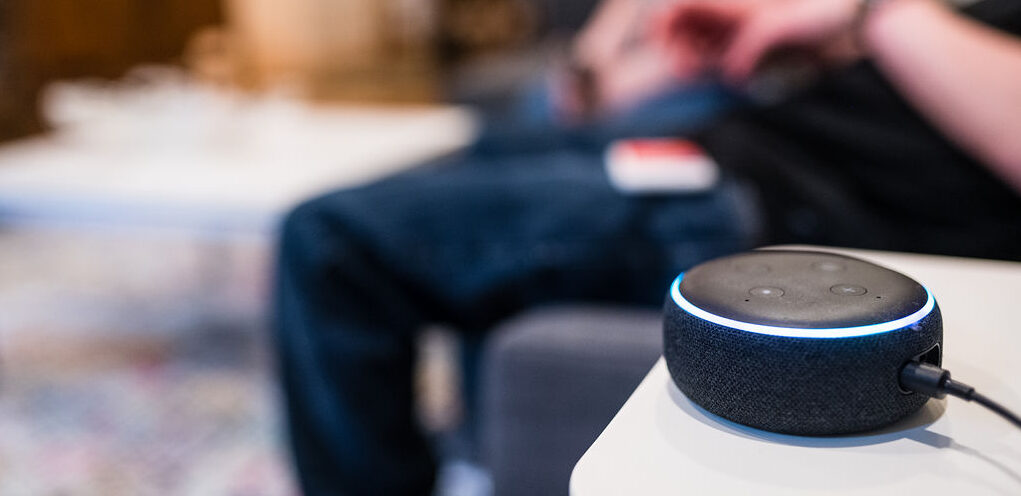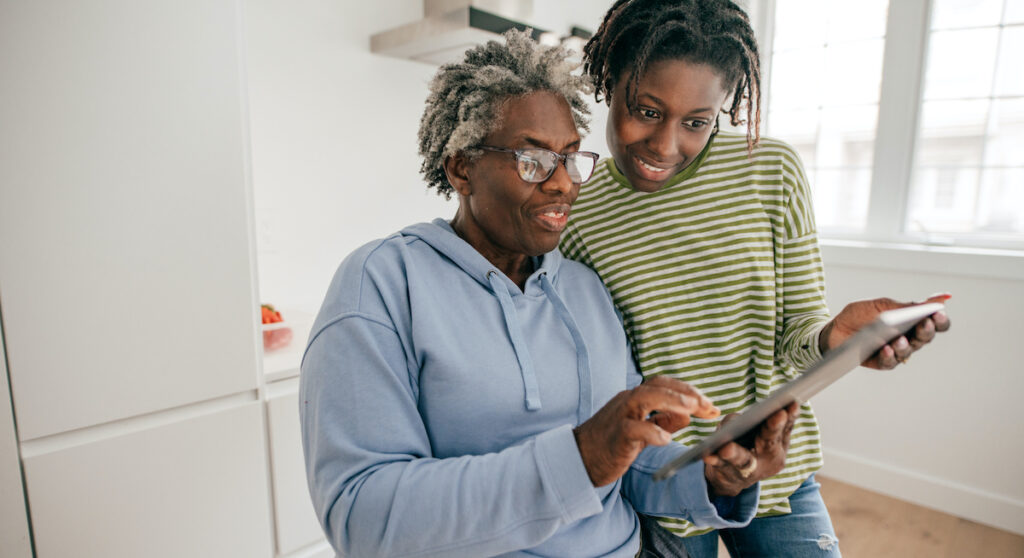By: Kirby Smith, Smart Homes Made Simple project consultant, and founder of SunKirb Ideas, LLC
You may be aware of how Alexa and Alexa services make it possible to control your smart home devices, set an alarm, get the news, or hear a joke (learn more about what you can do with smart speakers and displays). However, Amazon has recently made a big push to expand Alexa into providing security services and services to assist with providing care to loved ones. This article reviews some of the best services and how you might use them.
Updates to Amazon Alexa Devices
Over the past two years Amazon has refreshed almost its entire line-up of Alexa-enabled devices, especially its Echo Show devices. Echo Shows incorporate functions that take them far beyond the typical smart speaker. They contain an array of microphones (giving them sharp “ears”), upgraded camera (allowing them to “see” a large area even with only ambient light), sharp displays that make it possible for you to read information from across a room, and enhanced speakers to give them crisp, clear sound. The third generation Echo Show 10 can also turn, keeping the screen facing toward you and allowing the camera to follow you, making video conferencing seamless even when you’re moving throughout the room.
What was once a device enabled with basic AI (like the ability to recognize a person and the sounds a person makes), today’s units can assist in new kinds of automation. They can, to a certain degree, act as sentries, watching and protecting your environment, and as assistants to providing care to loved ones.
A Note About Privacy
This may seem intrusive or “creepy,” but the risk of being monitored or eavesdropped on, and of security breaches is low in comparison to cell phones and computers. To break it down, all services on an Amazon Echo run through one company (Amazon) and one service (Alexa). It is simple to control privacy and security through the Alexa app. You only need to go to one place (Settings) in the app to change settings and check what your device has heard or transmitted. With cell phones and computers, on the other hand, each app and service (operated by individual companies from all over the world) can access your camera and microphone, as well as information about your use once you have given permission. It is arguably much harder to control your privacy and security on these devices.

Alexa Guard: Home Security
A primary area where Alexa services have expanded is home security. If a household has Alexa devices scattered throughout their home, these devices (along with many other smart home devices) can act as security monitoring and alarm systems. These systems work so well that companies like ADT are tapping into these devices to boost their own security services.
The primary service under Alexa for security is Alexa Guard. There are two tiers, the free version and the paid version, called Guard Plus. The free version of Alexa Guard is a home security feature you can turn on in the latest models of Echo and Echo Show. When you enable Alexa Guard (find it in Settings in your Alexa app), your Amazon Echo device listens for suspicious sounds when armed, such as when you sleep, when you’re away from home, or other instances when you want some extra protection. You can activate it by saying something like “Alexa I’m leaving,” or “Alexa turn on Guard.”
If Guard detects something out of the ordinary, Alexa will notify you through your mobile device so you can check in (remotely look and listen through your devices) and take the appropriate action to keep your home safe. Guard can listen for things like glass breaking from a potential intruder or your smoke alarm/carbon monoxide detector going off.
Alexa Guard sends notifications to your phone. But you can also receive smart alerts through your home security system if you have a system that works with Alexa Guard, such as Ring Alarm, ADT, or Scout Alarm.
In addition, if you have smart home devices to control lighting in your home, such as smart bulbs, smart switches, or smart plugs, Guard can be set to turn lights on and off while you’re away to make it seem as if you are home.
Alexa Guard Plus expands on these services for a monthly charge of $4.99, or annual fee of $49. With this paid version, you gain access to Alexa Emergency Helpline to speak with Amazon agents who can call emergency services for you when you say the voice command, “Alexa, call for help” or “Alexa, emergency.” Additional smart alerts can identify a variety sounds in your home (like footsteps, people talking, or a door closing). There are also sound deterrents (like a barking dog or a siren) that can play when there’s activity or motion inside your home to scare away intruders.

Alexa Together: Caring for Loved Ones
In addition to home security, Alexa services have also expanded to include support for those concerned about looking out for a loved one. Whether you have a parent who is aging but wants to live independently, or a child who has a developmental disability and is moving out to live on their own, a new service called Alexa Together may be able to help.
*Important: Before installing any kind of remote support technology, it is critical that the individual receiving the care and support understands and consents, to the best of their ability, to the devices and support systems being put in place. Remote support technology is not a replacement for direct care.
Alexa Together is an expansion and replacement of Amazon’s now discontinued, free Care Hub service. Amazon launched Alexa Together on December 7, 2021, and this new service makes use of Echo devices to offer features like fall detection, activity alerts, and emergency services.
All a caregiver needs is a smartphone with the Alexa app installed. You will also need one subscription to the Alexa Together service which costs $19.99 per month, or $199 per year. Right now, you can sign up for a free six-month trial.
Alexa Together is designed to be as unintrusive as possible for the person receiving the care and largely works in the background. It is also adjustable – the caregiver and the recipient of the care can use it at the level that is comfortable for them. Depending on the comfort and ability of the person receiving the care, it may be simplest for the caregiver to purchase the Echo directly and complete the setup themselves. They can then take the device to the loved one’s home and switch it to their Wi-Fi. The device and service setup are straightforward as the device will guide you through the process.
Alexa Together provides the following:
- 24/7 Urgent Response – Trained agents can be contacted through the device to assist the loved one when they say “Alexa, call for help.” This connects them to the Urgent Response line, where a professional can contact police, the fire department, or an ambulance if needed. If a loved one uses the Urgent Response feature, Alexa will notify the designated caregiver.
- Fall Detection – Alexa Together incorporates fall detection services from two third-party companies, Assistive Technology Service (ATS) and Vayyar. Vayyar Care is a wall-mounted sensor that can detect when a fall occurs. SkyAngelCare by ATS is a fall-detection pendant worn around the neck. When Vayyar Care detects a fall or the loved one presses the SkyAngelCare pendant button, Alexa can ask if they would like to call Urgent Response and alert emergency contacts.
- Activity Feeds – Alexa Together includes activity alerts for caregivers, helping you stay updated on how things are going by providing snapshots of your loved one’s Alexa and smart home interactions. The caregiver can set up custom alerts, while the loved one goes about their day interacting with their Echo or smart devices as normal. Example alerts include notifications when the first interaction takes place each day, when no activity has taken place by a certain time each day, and anytime an activity takes place. These activity alerts are high-level, showing the caregiver that an Alexa interaction took place, but not what it was. Terms are generic, for example letting the caregiver know the loved one used Alexa for “entertainment,” but not what song or podcast was played. This can be very useful for alerting the caregiver if a reminder, such as “Take your medicine at 9:00 a.m.,” is ignored.
- Remote Assist – When this feature is enabled by the loved one, a caregiver can set up Alexa features remotely and manage some settings. Caregivers can do things like set reminders, add contacts, add and check off shopping list items, and link music services. The loved one will need to allow access for the caregiver to use Remote Assist.
- Circle of Support – Additional family members or other caregivers can join you to support your loved one, making it possible for them to get support from others if you aren’t available.
Regarding privacy, Amazon states the following:
“As with Alexa and all Echo devices, Alexa Together is designed with multiple layers of privacy protection. Your loved one will need to allow access for you to use certain features like Remote Assist and adding additional family members to your circle of support. They can revoke this access or delete the Alexa Together relationship at any time. Likewise, you’ll only be shown high-level information about your loved one in the activity feed.”
It will be interesting to see how companies that provide professional caregiving might start to tap into services like this. There are many ways it could help and augment the care that is given but should not be seen as a replacement for direct care where needed.
Smart speakers and displays can do many things to help you achieve your goals. Learn more about smart speakers and displays. Already convinced but not sure how to pay for the devices you need? Learn more about funding your smart home technology.

